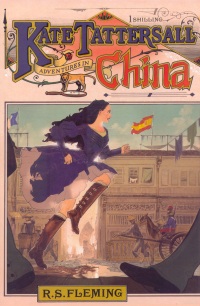| ________________
CM . . .
. Volume XX Number 19. . . .January 17, 2014
excerpt:
In the spring of 1849, 15-year-old English noble Kate Beaufort, spurning her parents’ efforts to arrange a marriage to a fellow noble, goes on a mission to China to deliver an advanced weapon on behalf of her older brother Jack, an inventor, to Henry Tattersall, a young doctor doing missionary work, someone that Kate is also interested in as a suitor. Joined in Egypt by her grandfather Sir Tom and his crew of retired British servicemen, Kate sails to Canton where she finds Henry is ill and arranges passage for his medical care in Bombay. With Henry out of the picture, Kate finds she now has to complete Henry’s Secret Service-mandated mission to assassinate Aloysius Napier, a fellow English noble and opium smuggler. Following clues she is led to by silk merchant Wu, Kate and Sir Tom journey upriver and are able to use Jack’s telescopic rifle to kill Napier, after which they flee back to Canton and board a ship to Bombay where more adventures await. The first of a projected 10-part series, Adventures in China explores aspects of history rarely covered in historical fiction for young people: colonial military espionage and subterfuge, not to mention drug smuggling and the Asian slave trade. The historical and geographic context is fascinating, especially in Kate’s observations about fellow passengers, Egypt, and the trading ports of the British mandate in China. Even more intricate that the elaborate plotting against Britain’s own subjects—explicitly ordered in the novel by foreign secretary Lord Palmerston—is the science of the weapons of the time, with Jack inventing what are clearly advanced weapons for this early age of guns. That part gives the book a somewhat “steampunk” appeal, although the technology is generally contemporary. Also depicted is very early photography, with Kate also tasked with using Jack’s “inverto camera obscura” to take photographs of other nations’ factories along the Chinese coast. And in a very uneasy but necessary scene, Kate is led by Wu to an opium den to investigate Napier, and there she finds herself “serving” opium to customers in order to listen in on their rambling conversations. It is scenes like these, suggesting some sexual vulnerability, as well as Napier’s trade of drugs for addicts’ own daughters as prostitutes, that suggest this book is not entirely aimed at middle grade children. At the same time, its somewhat generic “adventures in” premise may seem unappealing to teens, which could leave the book in a slight no-man’s land. Although much of the description of context and technology is expressed in economical words, there is a little too much description of Kate’s ever-changing wardrobe, mentioning almost every outfit she changes into and how it might help her participate in very un-ladylike adventures. It is also a little disingenuous to call the series Kate Tattersall, giving away from the very beginning that she must marry Henry in a later installment. And while the author’s note at the end explains some of the historical context—a bit of a relief for anyone unfamiliar with it already—there is a little too much emphasis placed on characters like Palmerston who are based on real British military and political leaders of the time. It would also have been good to have explained some of the archaic geographical names like Canton (modern Guangdong) and Nam Ky (southern Vietnam). Kate, herself, is a spunky character, fascinated from an early age by Jack’s tinkering, considered such an excellent shot that Palmerston, himself, approves of her participation in the clandestine mission. Her rejection of a passive female role is typical of this type of book, but her explicit pursuit of a husband, albeit of her own choosing, keeps one foot in the gender reality of the time and occasionally makes her character confusing, as opposed to conflicted. Sir Tom and his friend Colonel Bob are appealing as aging career military officers, unafraid to speak their minds, and as warm on the inside as they are crusty on the out. Few Chinese characters are explored with any depth, even Wu, although his bitterness about the effect of drugs on Chinese society is well expressed. The narration is rather formal but generally flows well, and the dialogue reflects a fairly simplified nineteenth-century usage. While not narrated by Kate, it is definitely written entirely from her point of view, including somewhat superfluous use of italicized thought quotes, often placed within paragraphs already containing dialogue and narration, making it somewhat choppy and unnecessary. Most unfortunately, the disappointing final paragraph offers a banal—even condescending—view of Kate’s future aspirations:
Despite its faults, there is much here to interest readers: history, intrigue, and technology. Recommended with reservations. Todd Kyle is the CEO of the Newmarket Public Library in Ontario.
To comment
on this title or this review, send mail to cm@umanitoba.ca.
Copyright © the Manitoba Library Association. Reproduction for personal
use is permitted only if this copyright notice is maintained. Any
other reproduction is prohibited without permission.
NEXT REVIEW |
TABLE OF CONTENTS FOR THIS ISSUE
- January 17, 2014.
AUTHORS |
TITLES |
MEDIA REVIEWS |
PROFILES |
BACK ISSUES |
SEARCH |
CMARCHIVE |
HOME |
